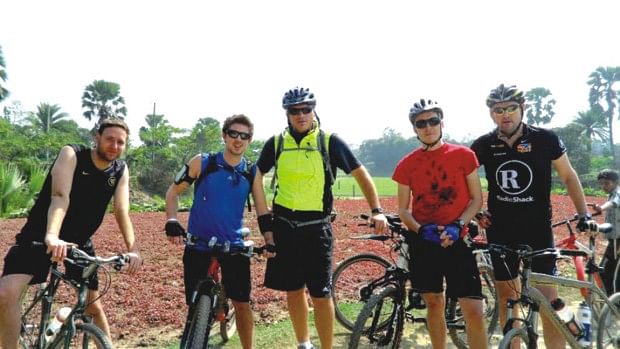| Home - Back Issues - The Team - Contact Us |
 |
| Volume 10 |Issue 12 | March 25, 2011 | |
|
|
Event Ride Of The Tiger Cycle Journey now Underway Sajid Chowdhury
Today, as you are reading this article, five men are cycling from the Italian Embassy in Dhaka to the ITC Sonar Hotel in Kolkata. Their journey is the climax of the Ride Of The Tiger campaign, a two-month effort to raise public awareness of the threatened future of Bangladesh's tigers. The men have decided to donate the funds earned from the campaign to the Sundarbans Tiger Project (STP), a dynamic non-governmental organisation that works for tiger conservation. “Around the beginning of 2011, Chris and I began discussing an idea for a trans-border bike ride, and we initially planned to do it alone,” said Massimo Franco, an employee of the Italian government and one of the cyclists. “But as more people heard about our idea, the riding team expanded, the organising team expanded, and we added more events to the campaign calendar. The organic growth of that initial idea has been inspiring, and it has shown us what can be accomplished with teamwork.”
One bike ride for two men soon became a ride for five, preceded by a massive fundraising event, all-day football tournament, an invitation to meet Her Royal Highness Princess Anne of the United Kingdom, press coverage, and a Spin-A-Thon on indoor fitness bikes at a premier gym. Each campaign element has aimed to tell people about the dire predicament of tigers in Bangladesh. While almost everyone we reached was aware of the predicament, almost none were aware of its severity. Worldwide, only 2,300 tigers remain in the wild, and the Sundarbans – a vast mangrove forest shared by India and Bangladesh – is home to what is almost certainly the largest single concentration of them. Even there, though, only three hundred to five hundred remain. The STP is one of the only organisations in the country that is working to protect them, through research and surveillance, capacity building of the Bangladesh Forestry Department, and efforts to increase public awareness of the need to adopt conservationist views of the tiger and its habitat. Although the STP receives support from the Zoological Society of London, the Wildlife Trust of Bangladesh, and the Forestry Department, it faces an epic uphill battle. Poaching, spurred particularly by demand for tiger derivatives in China, remains a lucrative business. Illegal logging and deforestation is destroying the Sundarbans. Climate change pushes tigers north, while human population expansion pushes people south. The inevitable result is tiger-human conflict.
Mitigation of this conflict is a core mandate of the STP. In Bangladesh, the killing of stray tigers is the most common, and perhaps the most understandable public response to an encounter, though it is often not a permanent solution, as another tiger may then move into the slain tiger's territory. As an alternative, the twenty-nine Village Tiger Response Teams of the STP, comprising a total of roughly two hundred volunteers who are trained to respond to tiger encounters, can potentially immobilise tigers and move them further into the forest, away from the possibility of interaction with humans. Earlier this year, one of the teams was able to do this in Satkhira. The incident received significant international press coverage. The STP also operates a boat-based Forest Tiger Response Team that travels to locations of tiger attacks. Its members are trained in first aid and will also travel into the forest to retrieve human bodies so families of the slain can prepare suitable burials. More broadly and looking to the future, the STP now works with partners such as the European Commission-funded Sundarbans Environmental and Livelihoods Security project to develop safe alternative livelihoods for people of the region, as human deaths often occur when people go into the forest to collect materials such as wood, honey and meat. Tiger conservation in Bangladesh is obviously a complex and sobering set of challenges with very human elements. Given the tiger's iconic status here, you might think conservation is a publicly and often-discussed issue. It is not. Awareness-raising initiatives such as the Ride Of The Tiger campaign are, then, all the more important. And while the funds raised so far are a just a drop in the ocean – roughly eleven thousand US dollars – perhaps the campaign can inspire others to pursue the cause. When asked about the future, Henry Churchill, Programme Coordinator at the Sundarbans Tiger Project and one of the cyclists, paints a disturbing picture that is nevertheless lined with optimism. “It is now entirely conceivable that tigers will be lost within our lifetime. One hundred years ago, the world had a hundred thousand tigers. That number has dwindled to less than three thousand. And without support, the tiger will almost certainly disappear in Bangladesh. We are not talking about huge numbers. We are talking about a few hundred. But we do still have time.” That optimism is unanimously shared by the other members of the campaign's organising team, largely because of the incredible public response that they have witnessed over the last two months. Overwhelmingly, people have wanted to come on board and contribute their own talents and expertise, which gives us hope that new, long-lasting partnerships with the Sundarbans Tiger Project are being formed. These relationships may just buy us some more time. Being a part of the campaign has been a privilege, and we hope it is just a beginning. How can you help? The Ride Of The Tiger campaign is supported by Maersk Bangladesh Limited, VFS Global, Re:Fit fitness studio, Dhaka Caledonian Society, Tapestry Bangladesh, Panache International, Big Blue Communications, Iqbal Hussain, Kim Walling, Jacqui Franco, and a number of other good-hearted people. If you would like to discuss ways that you can help the Sundarbans Tiger Project, contact Henry Churchill at [email protected]. If you would like to make a donation that will go directly to the Sundarbans Tiger Project, visit http://www.justgiving.com/RideOfTheTiger. To read up-to-date news of the ongoing bike ride, please join us at http://www.facebook.com/RideOfTheTiger. Sajid Chowdhury is a member of the Ride Of The Tiger organising team and the founder of Big Blue Communications.
|
||
Copyright
(R) thedailystar.net 2010 |
 “There's no better way to see Bangladesh than on a bike, and the public response we receive when we stop for water during our training rides has been really positive. Most importantly, this experience is a great chance for us to raise the profile of the Sundarbans Tiger Project.”
“There's no better way to see Bangladesh than on a bike, and the public response we receive when we stop for water during our training rides has been really positive. Most importantly, this experience is a great chance for us to raise the profile of the Sundarbans Tiger Project.”
